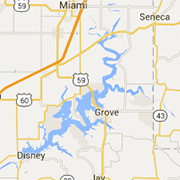Health Care Costs

Grove physician Tom Riggs says our current health care system must change.
"Over the last 10 years, the average family premiums have increased by 55 percent, outpacing workers' earnings, which have increased only 26 percent." - Dr. Tom Riggs
Health care costs are crippling our economy.
Grove physician Dr. Tom Riggs says that Americans cannot afford to spend 25 percent of GNP (gross national product) on health care. Speaking to the Grove Rotary Club, Dr. Riggs outlined the history of health care in America and why he says it must change.
At the beginning of the 1960s, 77 percent of all medical insurance was paid for by individuals, not employers. But with the establishment of Medicare in 1965, and the need to attract workers, when the 1960s ended, employers were paying for about 77 percent of medical insurance costs.
Riggs noted that in 1970, most of the world's economies were paying approximately 6 to 7 percent of their gross national product (GDP) for health care including the United States. But during the next 50 years, the cost of health care in America increased three to five times the rate of the increase in wages, gross domestic product, and inflation which made employers pay nearly double the health care costs of most developed countries.
About a decade ago, Congress was faced with the projection that health care expenses would represent 20 percent of our GDP by 2020 and 25 percent by 2025. It placed American businesses at a major disadvantage in the world's economy. It would mean that one in every 4 dollars of GNP would be dedicated to healthcare. Employers were paying about $20,000 a year for each employee's medical coverage.
Another issue is the rising costs of drugs. Riggs pointed out that in 2004 Congress passed a law saying there would be no competitive bidding for drugs in Medicare Part D insurance. This took medications out of the competitive free market. "Consequently, we pay $9,000 month for the drug Humira used in autoimmune disorders while Canadians pay $3,000; we pay $450/mo. for insulin and Canadians pay $50 per month; Avastin, a chemotherapeutic drug costs nine times as much in the U.S. as Canada.
"The government's answer to this economic flood was the 2010 Affordable Care Act which did not end up passing Congress nearly as originally proposed as it was to be influenced by a health care lobby that contributed more money to Congressional lobbying than the next five largest lobbyists combined.
"By the time it had gone through Congress it was a political compromise and public option had been discarded and pharmaceutical pricing had not been addressed."
It did reduce the number of uninsured decreased from 47 million to 27 million and the number seeking medical bankruptcy decreased by 50 percent by 2016."
Riggs noted that since the act was passed, there has been a decline in the rapid rate of increasing the cost of health care, but those costs are still greater than the increase in the gross domestic product. Besides, Congress has failed to address the pharmaceutical cost issue.
Riggs pointed that in 2010, $64 out of every $100 spent on health care came through the state or federal government. "We had a two-thirds socialized system, which was functioning very inefficiently."
Riggs says health care premiums have increased at a rate greater than both wages and inflation since the passage of the Affordable Health Care Act in 2010. Over the last 10 years, the average family premiums have increased by 55 percent, outpacing workers' earnings, which have increased only 26 percent.
The solutions are not easy ones. "We can repeal the Affordable Care Act and continue to work in a patchwork, inflationary system, without universal health coverage. But that is what led us to the problems of 2010. In 2010, $64 out of every $100 health care dollar came through the state or federal government. We had a system that was functioning very inefficiently.
"Or we can fix the Affordable Care Act with cost controls and a public option. This approach has been a successful model in Germany, Denmark, and Switzerland.
"Or we can evolve into a single-payer system or a hybrid system with a public option. Medicare is one example of a single-payer system."
Riggs said a single-payer system would be much like social security. "It is socialized insurance with the option of purchasing supplemental insurance. There would be a full range of basic benefits. It has the potential of a $600 billion savings per year and 95 percent of Americans will pay less for health care."
The two major primary care organizations, the American College of Physicians and the American Academy of Family Practice have both endorsed the single-payer system.







